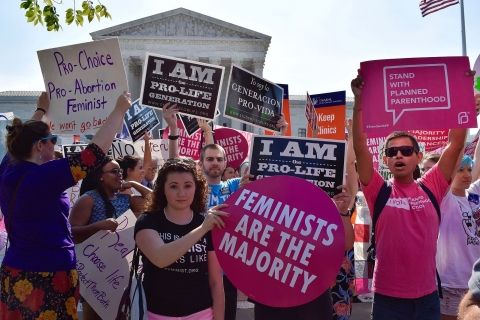Pro-Choice v. Pro-Life: The Abortion Debate Takes Center Stage with State Constitutional Referendums in Three States

By Shannon Rutherford
Since Roe v. Wade, a woman’s right to and access to abortion has been one of the most hotly contested issues during election cycles. The 2018 midterm elections are no exception. Three states—Alabama, Oregon, and West Virginia—have ballot initiatives aimed at abortion access.
In Alabama, the proposed Constitutional Amendment would give a fetus personhood rights. The Amendment would make it “state policy to ‘recognize and support the sanctity of unborn life and the rights of unborn children, including the right to life.’” The proposed Amendment contains no carve out exemptions for abortion in a crises situation.
In Oregon, the proposed Constitutional Amendment would end all public funding for abortions; however, the Amendment does state that if the abortion is “medically necessary or required by federal law” then public funds could be used. This would reach woman who are public employees or who rely on Medicaid as their primary form of health insurance.
In West Virginia, the proposed Amendment is known as the “No constitutional Right to Abortion Amendment” and would severely restrict public funding for abortions. The Amendment states that the West Virginia Constitution has nothing that “secures or protects a right to abortion or requires the funding of abortion.” In a 1993 West Virginia Supreme Court of Appeals case, Womens' Health Center of West Virginia, Inc. v. Panepinto, the Court held that denying Medicaid coverage of an abortion for poor women was discriminatory in its effect. Since then, Medicaid coverage in West Virginia has paid for abortion; however, if passed, the Amendment would render the case ineffective. Beyond having the ability to ban publicly funded abortions, the Amendment would also allow state legislatures to enact more restrictive abortion laws and the lead sponsor of the Amendment stated that was the main goal of the Amendment. The proposal does not contain a “carve out” for rape and incest even though there was a proposed addition of an exception, which was rejected.
Many states already have made abortion access restricted. For example, in West Virginia, there is only one abortion clinic which is in Charleston, West Virginia. The city is extremely far away for citizens along the southern border and northern and eastern panhandles. In general, the number of abortion clinics have declined six percent primarily in rural areas across the country. These proposed Amendments, particularly the ballot initiatives in Alabama and West Virginia, appear to impose the Planned Parenthood of Southeastern Pennsylvania v. Casey standard of an “undue burden” because the Amendments could be a mechanism for the legislature to place a “substantial obstacle in the path of a woman seeking an abortion before the fetus attains viability.” The Alabama proposal gives personhood status to a fetus, which was rejected in Roe, and the West Virginia proposal would allow an increasingly conservative legislature to enforce more restrictive laws. The Medicaid funded portion of the West Virginia and Oregon proposals would likely not give rise to a Roe challenge because there is generally a federal ban on Medicaid funding of abortions, but some states allow Medicaid funding to be extended to abortions. The proposed Amendments come at a time when several states have begun passing extremely restrictive abortion laws, which points towards a potential Supreme Court challenge to Roe v. Wade and Planned Parenthood in the future. Now with a more conservative Supreme Court, it leaves open the question of how the Court would rule on restrictive state constitutional amendments, which could lead to a long standing question of if Roe and Planned Parenthood would be overturned. Thus, these ballot initiatives are important to the national conversation about abortion and what potentially lies ahead in abortion rights and access.
